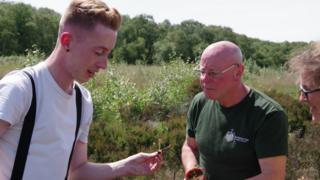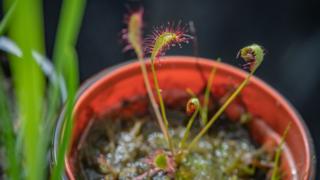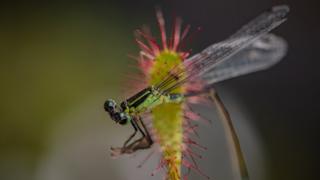
Media playback is unsupported on your device
Endangered carnivorous plants are being reintroduced to parts of England in an attempt to reverse their decline.
Botanists say the “fascinating and beautiful” great sundew is extinct in many areas, due to loss of wetlands.
With tentacles that trap and digest insects, the plant is one of a dozen or so meat-eating plants native to the UK.
Charles Darwin was captivated by the species, compiling drawings and experiments for his book, Insectivorous Plants, published around 1876.
He said he cared more about the genus Drosera, which means dewy in Latin, than the origin of all the species in the world.
“It’s a very rare species,” said Joshua Styles, a 24-year-old from Cheshire, who has set up his own conservation charity, the North West Rare Plant Initiative, to conserve rare flora, including the great or English sundew (Drosera anglica).
“In England it’s red-listed as endangered and it occurs in less than 20 sites and hence its rarity and status instigated me wanting to reintroduce it.”
The Red List is an inventory that shows the conservation status of different global species. It’s compiled by the International Union for Conservation of Nature (IUCN).
 Image copyright
Image copyright
Chester Zoo
Joshua Styles (left) with a great sundew seedling
What is the plant and where does it live?
Once commonly found in England, the plant has suffered a dramatic decline over the last century.
Changes in land use have led to the drying of the wetlands and peat bogs it needs to survive.
The great sundew is found more widely in Scotland and Wales.
How is the plant being reintroduced?
Joshua Styles was able to cultivate the plant from leaf cuttings taken from a few small populations, which have clung on to survival in Cumbria.
He reintroduced 10 of the plants at Risley Moss near Warrington, working with Chester Zoo and the Lancashire Wildlife Trust.
The meat-eating plant should thrive in this habitat and start multiplying.
“Every year when it flowers, it produces tens of thousands of tiny seeds that look a bit like dust,” he said.
“Planting out 10, it might not sound a lot, but the number of seeds they produce, I’m hoping for a healthy number of seedlings next year – hopefully numbering hundreds.”
 Image copyright
Image copyright
Chester Zoo
Sundews were one of the first carnivorous plants to be studied, attracting the attention of Charles Darwin

The great sundew (Drosera anglica)
- Plants usually draw nutrients up from the soil through their roots; carnivorous plants have evolved to feed on animal protein
- The great, or English, sundew has many tiny “tentacles” on its leaves, which excrete droplets of a sticky, sweet-smelling liquid, which attracts passing insects
- The sundew’s tentacles then tighten around its prey, drowning the insect in the sticky fluid
- Digestive enzymes are slowly secreted, breaking the insect down into a nutrient-rich meal.

 Image copyright
Image copyright
Chester Zoo
Insects are attracted to the plants by the glistening leaves
The young conservationist was hooked by botany at the age of seven, and has been studying plants ever since.
He says it’s important to conserve meat-eating plants for their benefits to the environment and biodiversity, and for their potential future benefits for us, such as as a potential source of new medicines.
Follow Helen on Twitter.












